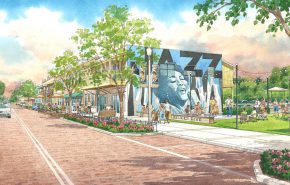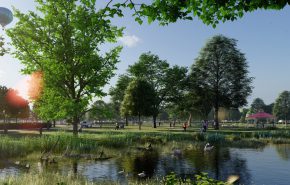![]() A team of specialists from GAI’s Community Solutions Group discusses how Augmented and Virtual Reality add impact to presentations and meetings and enable the community to play an immersive role in parks and public space planning.
A team of specialists from GAI’s Community Solutions Group discusses how Augmented and Virtual Reality add impact to presentations and meetings and enable the community to play an immersive role in parks and public space planning.
Maybe you’ve visited another universe using a Virtual Reality (VR) headset, or you’ve found fantastic creatures on a familiar street with the aid of Augmented Reality (AR) and a smartphone. Now, VR and AR are being used to great effect at public meetings, presentations, and workshops, where the technologies enable community stakeholders to visualize a range of landscape architecture designs for parks and other public spaces.
Enhanced Visualizations, Presentations and Meetings
“Virtual reality and augmented reality are related technologies that essentially let us present enhanced versions of real-life environments,” said former GAI Urban Planner Wes Shaffer, AICP.
“The technology allows us to add a really attractive component to our presentations and public meetings that improves upon just looking at a plan, which might be difficult for some people to interpret,” said GAI Landscape Designer Andrea Penuela. “VR and AR present the public with three-dimensional concepts that communicate ideas and designs much more effectively.”

The groundbreaking for the Lorna Doone park renovation project took place on June 4, 2019. The city of Orlando anticipates that the GAI redesigned park will reopen in late spring 2020.
For example, a rendering of GAI’s landscape architecture design for Orlando FL’s Lorna Doone park presents a 360-degree view of the completed project. Using a standard desktop computer and mouse, the viewer can navigate right, left, up, and down for a full view of the design; using a VR headset, the viewer is immersed into the design and can get a 360-degree view of the park with a simple turn of the head.
At a recent public meeting in Gainesville, FL, GAI staff presented an Augmented Reality visualization of an upcoming project site that allowed community and municipal attendees to take part in the landscape architecture design discussion. The City of Gainesville had reached out to GAI to host an interactive public meeting to explore possibilities for revitalizing the city’s Cabot-Koppers superfund site.
Augmented & Virtual Reality Power Public Interaction
To bring attendees into the process, the GAI team created coded cards representing specific design elements—gardens, benches, playgrounds, etc.—that could be arranged on a grid map of the project site. When the coded cards were scanned with the GAI team’s Augmented Reality software, it produced visuals that incorporated the proposed design elements into images of the project site. The cards and their positions could then be re-arranged to produce new designs in real time.
![]()
“What we had were waves of participants who were totally intrigued and engaged,” said Shaffer. “As the participants placed and then re-arranged the cards, it was amazing to listen to them tell stories of what would be happening in these various areas. The exercise seemed to make it all real.”
The attendees even began to make up design elements of their own, positioning them on the grid map using Post-It notes. “It really demonstrated that the technology is a great way to engage people and get them excited about what’s going on,” said Penuela.
![]()
![]()
At an open house kickoff for Orlando Park Vision, GAI representatives offered a similar interactive Augmented Reality interface that empowered community members and city staff to become actively engaged in exploring park design possibilities. “It drew people in and allowed them to immerse themselves and truly feel involved in the park projects that will be coming to the City of Orlando,” said Shaffer.
The technology opens minds, stimulates important conversations, and helps work toward consensus.
Engaging Future Landscape Architects
GAI representatives participated recently in a ‘teach-in’ at English Estates elementary school in Fern Park, FL. The volunteers lead a presentation that introduced kids to landscape architecture and its possibility as a career goal, then brought the discipline to life using a simplified version of the VR/AR interactive map.
![]()
Using a felt map and paper puzzle pieces representing the design components, kids worked alongside GAI Landscape Architects to create their own park. The youngsters moved around the various elements until they came up with their ‘perfect’ park design—then a snapshot was then taken, rendered at the GAI office, and the kids received the resulting VR representation of park they had created.
![]()
Next Generation, Now
The power and promise of Augmented and Virtual Reality for presenting landscape architecture and other community development designs lay it its ability to merge traditional and modern methods of communication in a way that is interactive and speaks across generations.
“The technology reaches beyond the people who work in our profession. It enhances visualization, opens minds, stimulates important conversations, and helps work toward consensus. And for kids growing up who are so involved in 3-D environment through video games, it offers a relevant way for them to understand the world,” said Penuela. “It does great things for outreach and public engagement—and I think that as today’s kids become the next generation of decision makers, Augmented and Virtual Reality will become an even more prominent way of communicating our work.”
Contact Andrea Penuela, 321.319.3074, for more information about GAI’s landscape architecture and other community development services. Learn more about GAI’s Community Solutions Group.
![]() Andrea Penuela believes that the places we experience throughout life play an essential role in forming our distinct identities. Through her work, Andrea strives to create physical environments that provide rich, positive experiences of place while representing and reflecting a community’s unique character.
Andrea Penuela believes that the places we experience throughout life play an essential role in forming our distinct identities. Through her work, Andrea strives to create physical environments that provide rich, positive experiences of place while representing and reflecting a community’s unique character.


